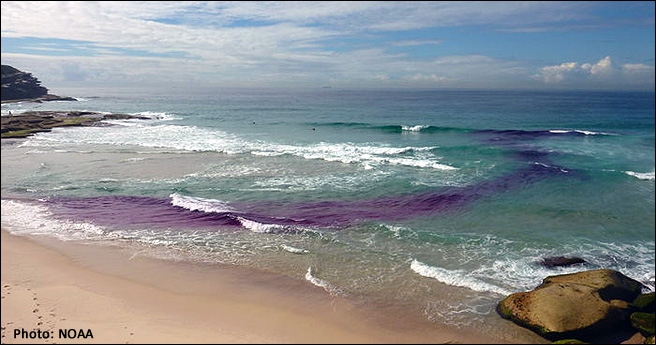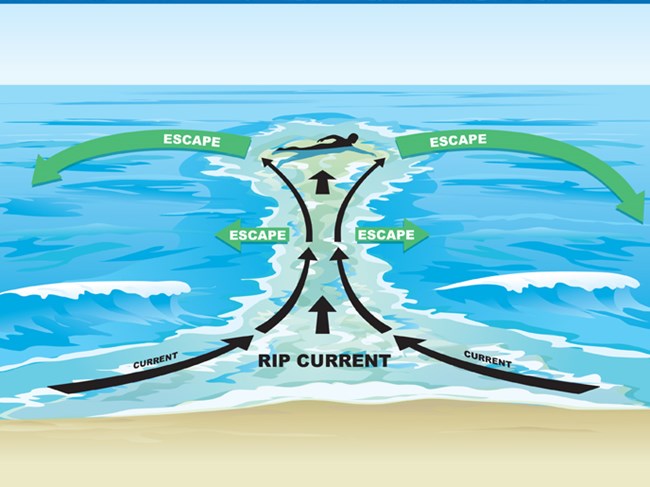Thousands of people travel to the ocean for vacation and many have rarely (if ever) swam in one. They choose beaches that are filled with tourists and assume that these must be safe places to swim — or they find a beautiful secluded beach and jump into the inviting waters.
But there are could be hidden dangers that they are unaware of.
Plan to be Safe and still have Fun:
Do some research in advance. Find out what the water conditions are and the type of coastline. Check out some travel guides. If you are planning on enjoying some water activities, find out if the conditions are conducive to those types of activities. Are the shores rocky or sandy? Are there strong currents, or is it relatively calm? Are the waters known for having dangerous rip currents? Are there lifeguards on duty?

Find out what the estimated times are for high tides and low tides. Use the buddy system when swimming, and if you are unfamiliar with the water, it is best to find a beach with lifeguards.
Conditions of the currents and waves can change rapidly in the ocean or large lakes like the Great Lakes. Be cautious when swimming during high tide and low tide, especially if you are unfamiliar with the ocean.
Several of us were sitting on a beach (quite a distance from the water’s edge) when suddenly we were surrounded by waves. Everyone on the beach was scrambling to grab their personal belongings that were now sweeping out to sea with the tide. There was no warning. One minute the waves were along the shoreline and the next they were engulfing the beach.
Always check for posted warning signs on the beach or beach warning flags.
Beach Warning Flags:
Typical colors are red, yellow, green, blue or dark purple–adopted by coastal communities worldwide.
- DOUBLE RED FLAG: Water Closed to Public
Conditions are too dangerous for even the strongest swimmer. Red flags signify a strong undertow or rough surf. - ONE RED FLAG: High Hazard – No Swimming
The surf is high or there are dangerous currents. - RED FLAG with a line through the SWIMMER: Swimming is Prohibited
- YELLOW FLAG: Caution – Medium Hazard
Ocean conditions may be rough and there is the potential for high surf, dangerous undertows, rocks, a sudden drop off, or a high population of bait fish that may attract predators. Children or swimmers that are not as strong should use a lifejacket, in case they get caught in the current. - GREEN FLAG: Low Hazard
It is safe to swim but still use caution. - DARK BLUE or PURPLE FLAG: Dangerous Marine Life
(usually flown with a Red or Yellow Flag)
Indicates that sharks, jellyfish, or other dangerous marine life have been spotted in the area. - YELLOW and RED FLAG: Safe to swim – Lifeguard on Duty
BEWARE OF RIP CURRENTS – the #1 Beach Danger
Rip currents (sometimes erroneously referred to as riptides or undertows) are the cause of about 80% of most ocean and large lake drownings. They are strong, narrow channels of water that can pull swimmers away from shore rapidly, no matter how strong a swimmer they are. They do not pull swimmers under the water.
Rip currents have been known to pull people in while standing in shallow water that is only knee-deep.
Swimmers oftentimes run into a problem when they panic and become exhausted while trying to swim against a rip current.
Watch your children when they are playing in the water — even when they’re right along the shore. Rip currents can pull children out to sea while in shallow water.
How to Spot Rip Currents:
 photo from University of Delaware
photo from University of Delaware
It may be difficult to identify the signs that a rip current is present because they can be very subtle. You may see one, all, or possibly even none of them (even though a rip current may be present). Keep in mind that rip currents can be right along shore and can pull you out when you are just wading. Before entering the water, look for the following clues:
- A channel of churning, choppy water.
- A line of seaweed, a “river” of foam, or debris that is moving steadily out away from the shore, as opposed to outside the rip where debris or foam is floating toward the shore.
- A notable difference in water color. It may be more opaque, cloudier, or muddier than the surrounding water or it may appear as darker or lighter than the water around it, depending on the angle of the sun.
- A break in the incoming wave pattern as they roll into shore. It may be an area where the waves are not breaking as quickly or as violently. The water may look flat or calm where the rip is as opposed to the breaking waves on either side.
- Rip currents can be prevalent around jetties, breaks in sandbars, piers, and groins (a long, narrow structure built out into the water perpendicular from a beach to prevent beach erosion).

What Should You Do if You Get Caught in a Rip Current?
You will know it when it happens. Suddenly you will feel a strong pull of water lifting you up and moving you rapidly out to sea. If you are aware of what is going on, you can calm yourself down by reminding yourself that you can swim out of a rip current — you just need to know how to do it. Remember that the rip current will generally dissipate outside the breaking surf, and it is a narrow channel of water.
IMPORTANT: HOW TO SAFELY SWIM OUT OF RIP CURRENT:

1. Most importantly, don’t fight the current or try to swim back to shore. This will cause you to become exhausted, and you won’t make any headway. A rip current can flow seaward at 5 to 8 mph.
2. Swim parallel to the beach (which is perpendicular to the rip current).
3. Once out of the current (it will end!), swim at an angle (away from the current) toward shore. Rip currents are concentrated in one area so you can swim out of them by going parallel to shore.
4. Sometimes the rip current is diagonal to shore; if you try to swim parallel to shore but aren’t making any progress, turn around and swim parallel to the shore in the other direction.
5. If you cannot swim out of the current, float or tread lightly until you are out of the current (they usually dissipate outside the breaking surf), and then swim back to shore at an angle away from the rip current. If treading water, face shore, wave your arms and yell for help.
6. Unless you are trained in swim rescues, do not try to swim out to rescue someone. Many drownings occur through these attempts. Instead, throw a floating device (even a cooler or ball) or toss out a rope. Shout directions to them loudly—urging them to swim parallel to shore—and try to keep them calm, while calling for help.
Sadly, people drown because they panic when trying to swim against a rip current. These lives could have been saved had they known how to swim out of rip current.
To check beach conditions in the U.S., check with the National Weather Service Surf Zone Forecast.
For more information on rip currents, check out Rip Currents on NOAA.gov.
For more insightful travel ideas, check out my book:
Know Before You Go: Traveling the U.S. and Abroad


Leave a comment